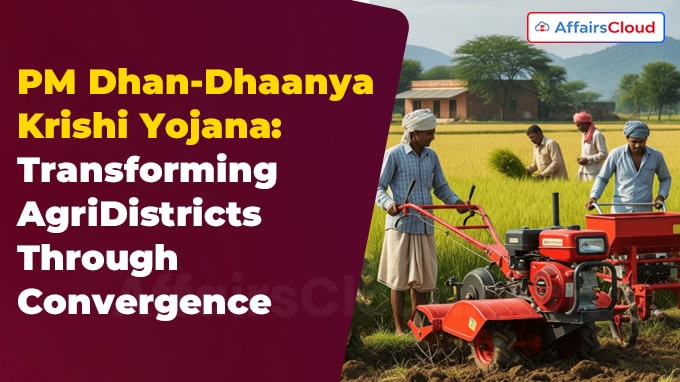 In July 2025, the Union Cabinet headed by Prime Minister(PM) Narendra Modi approved the ‘Prime Minister Dhan-Dhaanya Krishi Yojana (PMDDKY)’, a landmark initiative for transforming India’s agricultural landscape.
In July 2025, the Union Cabinet headed by Prime Minister(PM) Narendra Modi approved the ‘Prime Minister Dhan-Dhaanya Krishi Yojana (PMDDKY)’, a landmark initiative for transforming India’s agricultural landscape.
- The scheme announced in the Union Budget 2025-26, with an outlay of Rs. 24,000 crores aims to catalyse growth in 100 agri-districts through saturation-based convergence of 36 Central schemes across 11 Ministries, over a six-year period starting from Financial Year 2025-26(FY26).
- The scheme draws inspiration from the National Institution for Transforming India (NITI) Aayog’s Aspirational District Programme (ADP) and is the first initiative to exclusively focus on agriculture and allied sectors.
About Prime Minister Dhan-Dhaanya Krishi Yojana (PMDDKY):
i.Objective: The 5 core objectives of the scheme are:
- Enhancing agricultural productivity
- Encouraging crop diversification and sustainable agricultural practices.
- Augmenting post-harvest storage capacity at panchayat and block levels.
- Improving irrigation infrastructure for reliable water access.
- Enabling greater access to short-term and long-term agricultural credit for farmers.
ii.Targeted Districts: The scheme identifies 100 districts based on low productivity, low cropping intensity and less credit disbursement.
- The allocation of districts across each State/Union Territory (UT) will be determined based on their share of Net Cropped Area (NCA) and the number of Operational Holdings (OH).
- At least one district from each state will be selected to ensure balanced geographic representation across the country.
Note: NCA refers to the total land area sown with crops during a particular agricultural year, counted only once, regardless of how many crops are cultivated on the same land within that year.
iii.District-Level Planning and Implementation: Each selected district under PMDDKY will establish a District Dhan-Dhaanya Krishi Yojana (DDKY) Samiti, chaired by the District Collector (DC) or Gram Panchayat (GP).
- The DDKY samite will prepare plans that will guide the coordinated implementation of all converging schemes in the district and progress will be tracked using 117 Key Performance Indicators (KPIs) on dashboard.
iv.Multi-Tier Governance: The scheme will be managed through a three-tier implementation structure comprising:
1.Committees at the district level
2.Steering groups at the state level
3.Oversight bodies at the national level
- Teams like the ones set up at the district level will also be formed at the state level to make sure that different government schemes work well together in the selected districts. At the central level, two teams will be created, one led by Union Ministers and another by Secretaries and senior officials.
- These teams will help with planning, smooth execution, and solving any issues that come up.
- To improve monitoring on the ground, Central Nodal Officers (CNOs) will be assigned to each district. They will regularly visit the field, check progress, and work closely with local teams.
v.Institutional and knowledge Support: For effective implementation, PMDDKY will also integrate support from key institutions:
- NITI Aayog will play a central role in providing strategic guidance, building capacity at the state and district levels, tracking district-level progress, developing a monitoring dashboard, and reviewing and guiding district-level plans.
- The Central or State Agricultural Universities will be paired with each district to serve as technical knowledge partners.
vi.Monitoring and Farmer Support: For transparency, participation, and real-time oversight, the following will be launched:
- Dedicated Mobile Application(App): It will be developed for farmers, offering multilingual content in regional languages.
- Dashboard/Portal: This will be created for monitoring progress.
- District Ranking Mechanism: This is introduced to foster healthy competition and motivate timely, efficient implementation.
vii.Expected Outcome: The scheme is expected to lead to:
- Higher productivity,
- Value addition in agriculture and allied sector,
- Local livelihood creation,
- Increase in domestic production,
- Achieving self-reliance
About Aspirational District Programme (ADP):
i.TheADP, launched in 2018, was designed to rapidly and efficiently transform 112 underdeveloped districts across India.
ii.It uses a 3-C approach (Convergence, Collaboration, and Competition) with the goal of sustainable development for underdeveloped districts in India.
iii.The Champions of Change Dashboard tracks progress on 49 key indicators, addressing critical areas like infant mortality, school dropout rates, sanitation, and crop productivity.




